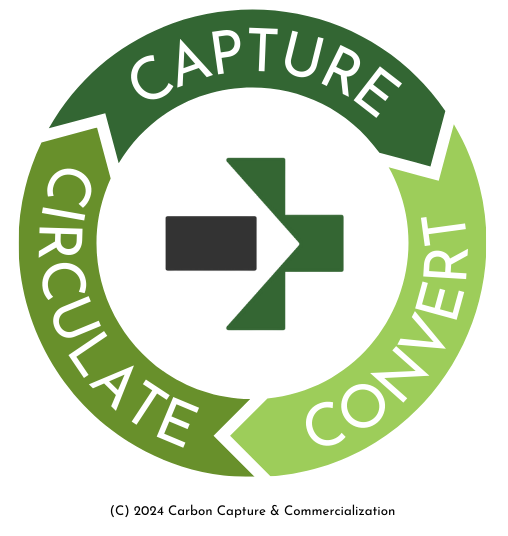
Pioneering CO2 Solutions in the $339 Billion Circular Economy
In an era of escalating climate disruptions and resource scarcity, the circular economy has emerged as a beacon of hope. Projected to reach $339 billion by 2026, this economic model promises to revolutionize how we produce, consume, and reuse resources. At the heart of this transformation lies an often-overlooked resource: carbon dioxide (CO2). Carbon Capture & Commercialization (CC&C) is at the forefront of this revolution, pioneering innovative solutions that turn CO2 from a problem into an opportunity.
The Circular Economy: A $339 Billion Opportunity
The circular economy represents a paradigm shift from the traditional “take-make-waste” linear model to a more sustainable “capture-convert-circulate” approach. Within this vast market, CO2 capture and utilization play a crucial role. With global energy consumption increasing by over 20% in the last decade alone, the need for sustainable practices has never been more urgent.
Capture, Convert, Circulate: CC&C’s Approach to CO2
CC&C’s innovative Direct Air Carbon Capture (DACC) technology embodies the principles of the circular economy:
- Capture: Using groundbreaking adsorber technology, CC&C captures CO2 directly from the air at less than $100 per ton—a game-changing cost that makes carbon capture economically viable for a wide range of industries. Our current capture efficiency is around 30%, with expectations to reach higher levels as we advance our technology.
- Convert: The captured CO2 is then transformed into valuable resources for various industrial processes.
- Circulate: These CO2-derived products are circulated back into the economy, reducing the need for virgin resources and closing the loop on carbon use.
Scaling Carbon Recycling: Overcoming Challenges
CC&C’s innovation addresses the high costs and inefficiencies that have limited widespread adoption of traditional carbon capture methods. “Our DACC adsorber only requires airflow to capture CO2, and the captured CO2 can be released on demand with minimal power,” explains Samir Adams, Managing Director of Technology at CC&C. “This design, coupled with our sub-$100 per ton capture cost, makes our solution both scalable and cost-effective.”
The modular nature of CC&C’s technology allows for flexible deployment in various spaces. Our compact units (1 cubic meter) can capture up to 225 tons of CO2 annually, while larger units (40-foot shipping containers) can capture up to 1,500 tons per year. This adaptability is crucial for integrating carbon capture into urban and industrial environments, where CO2 concentrations can be significantly higher than in rural areas.
AI-Enhanced Operations
To maximize efficiency, CC&C is developing a two-level AI approach. Local AI within each capture unit will fine-tune operations and proactively maintain unit performance. On a regional level, cloud AI will collect data from sensors—such as weather conditions and CO2 density—to optimize unit placement across deployment sites. This dynamic approach aims to react to environmental changes in real time, further enhancing capture rates and minimizing costs.
CO2 in the Circular Economy: Applications and Impact
The applications of captured CO2 in a circular economy are vast and varied, including use in industrial processes, agriculture, synthetic fuel production, and building materials. By turning CO2 from a waste product into a valuable resource, these applications not only reduce emissions but also create new economic opportunities.
Innovation and Competitive Edge
CC&C’s technology leverages patent-backed adsorptive materials and durable substrates, ensuring higher capture efficiency, durability, and cost-effectiveness compared to traditional systems. This unique combination positions CC&C at the cutting edge of material science in carbon capture, offering a more versatile and cost-effective solution than many existing technologies in the market.
A Call to Action: Embracing CO2 Solutions in the Circular Economy
As we face the dual challenges of climate disruptions and resource scarcity, embracing circular economy principles—including innovative CO2 solutions—is no longer optional. It’s a necessity for sustainable progress.
“Addressing resource scarcity and waste is crucial for our future,” Adams emphasizes. “By adopting practices that prioritize capturing, converting, and circulating CO2, we’re taking critical steps towards a more sustainable and resilient economy.”
The transition to a circular economy, with carbon capture and utilization as a key component, requires collective effort. We call upon policymakers to create frameworks that incentivize these technologies. Industry leaders are encouraged to explore partnerships and investments in carbon capture as part of their sustainability and circular economy strategies.
You can read more from our press release.
Safe Harbor Statement: This article contains forward-looking statements that involve risks and uncertainties. Actual results may differ materially from those discussed here, as ongoing R&D and evolving market conditions may impact CC&C’s commercialization timeline and outcomes.
